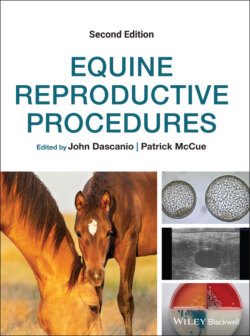Читать книгу Equine Reproductive Procedures - Группа авторов - Страница 15
Оглавление4 Placement of a Tail Rope
John J. Dascanio
School of Veterinary Medicine, Texas Tech University, USA
Introduction
The mare’s tail is often tied to the side to keep it from interfering with access to the rectum or reproductive tract. Horse tail hairs can be very abrasive to mucosal tissue or can lead to bacterial contamination from dirt/fecal contamination. In most cases the mare’s tail should be tied to her body so that if she were to fall down or jump out of stocks, the tail would not be injured. If the tail is tied to a rigid structure, such as the stocks, it should be tied with an elastic cord that is attached to a lightweight piece of twine that would break when significant tension is placed on it.
Equipment and Supplies
Tail rope equal to 2× the length of the mare, bungee cord, tail wrap, twine.
Technique for Tying a Tail Rope
Being careful to not stand behind the mare, the tail is grasped and the tail dock (or end) is located.
The running end of the rope (short end) is laid across the tail hairs just caudal to the tail dock (Figure 4.1).
The tail hairs are flipped upward and over the rope (Figure 4.2).
The running end of the rope is passed under the tail and over the flipped tail hairs (Figure 4.3).
A bight (loop) from the running end of the rope is tucked under the rope encompassing the tail and the standing part of the rope (longer end) is pulled to tighten the tail rope (Figures 4.4 and 4.5).
The standing part of the rope is then passed over the mare’s back so that if the tail is moved to the left side of the mare’s body, the rope is passed over her back to her right shoulder. The rope is then passed between her front legs. It is then passed over her back and tied with a quick release knot at her back (Figure 4.6).
This method works well when having to breed one mare, especially if there are no stocks around.
Care should be exercised as some mares may find the rope around their chest constricting and may need time to acclimatize to it.
Technique for Using an Elastic Cord to Tie the Mare’s Tail to the Stocks
The mare’s wrapped tail is encompassed by a stretchy cord such as a bungee cord with both ends of the bungee remaining free (Figure 4.7).Figure 4.1 The running end of the rope (short end) is laid across the tail hairs just caudal to the tail dock.Figure 4.2 The tail hairs are flipped upward and over the rope.
The bungee cord is hooked to a loop of twine attached to the stocks (Figure 4.8). The twine will break if too much tension is placed on it (due, for example, to the mare jumping out of the stocks). The bungee cord should never be directly attached to the stocks.Figure 4.3 The running end of the rope is passed under the tail and over the flipped tail hairs.Figure 4.4 A bight (loop) from the running end of the rope is tucked under the rope encompassing the tail.Figure 4.5 The standing part of the rope (longer end) is pulled to tighten the tail rope.Figure 4.6 The standing part of the rope is passed over the mare’ back to her right shoulder. The rope is then passed between her front legs. It is then passed over her back and tied with a quick release knot at her back.Figure 4.7 The mare’s wrapped tail is encompassed by a stretchy cord such as a bungee cord with both ends of the bungee remaining free.
The bungee cord is a much quicker method of holding the tail out of the way, especially if a Velcro® reusable tail wrap is used. This method works well when multiple mares are checked for cyclicity.
Figure 4.8 The bungee cord is hooked to a loop of twine attached to the stocks.
Further Reading
1 Leahy JR, Barrow P. 1953. Restraint of Animals, 2nd edn. Ithaca, NY: Cornell Campus Store.
